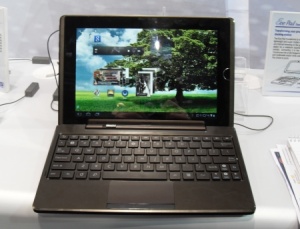Nvidia earnings lift off with Tegra growth

Graphics specialist Nvidia has reported strong first-quarter earnings thanks to a major boost in its Tegra mobile device chip business.

Tegra-based devices such as the Asus Eee Pad Transformer (above) have driven profits in Nvidia's consumer products business. Photo credit: Jack Clark
On Thursday, the company reported profits of $135.2m (£83m) and revenues of $962m. Revenues were up 8.5 percent on the previous quarter's $886.4m, but remained down on the previous year's high of $1bn.
Profit was down on the previous quarter's $171.7m, but that figure was so high because the company received $57m from Intel as part of a new cross-licensing deal. When this figure is discounted, the previous quarter's profit reads as $114.7m, meaning that profits were up around 10 percent.
"Our core GPU businesses are solid, with expanding revenues and margins," the company's chief executive Jen-Hsun Huang said in a statement. "And this quarter, our Tegra mobile business took off."
Revenues from the company's consumer products business, which includes Tegra phone and tablet products and embedded processors, were a record $122.6m, up 78.2 percent on the previous quarter. The revenues were driven by several products based on Tegra coming to market, including the Asus Eee Pad Transformer, Dell Streak and Motorola Xoom tablets, and the Motorola Atrix 4G and LG Optimus 2X smartphones.
Tegra is a low-powered processor for mobile devices that marries a CPU and a GPU onto the same die, forming a system-on-a-chip (SoC). It is a key product for the company's mobile-device strategy.
Icera purchase
Besides Tegra, the company said during an earnings call that its acquisition of baseband processor designer Icera, announced in early May, would also be significant for its mobile strategy.
"Not only is this combination [of Tegra and Icera] strategically powerful in the market, we expect it will also drive growth for both Tegra processors and Icera-based bands," Michael Hara, Nvidia's senior vice president of investor relations, said on the earnings call.
"We think that the ability to offer both processors... gives us the opportunity to leverage the momentum of Tegra and also the quite broad penetration [Icera has] already achieved with carriers all over the world to increase the momentum of both processors," Huang said on the call. "We also see that in the vast majority of the projects that we're working on, whether it's tablets or super-phones, the ability to keep the two processors separate allows us to mix and match the best processors for the devices that we're in."
The only troubling segment for the company was its Professional Solutions business, which remained relatively flat. The segment includes workstation graphics and the supercomputing-friendly Tesla chip. It failed to attain the heights of its previous quarter, though the company expects the sector to do well in the future.
"There's several million workstations sold per year," Huang said. "When those workstations become supercomputing workstations and are used for simulation as well as visualisation, I think we're going to see a really significant market opportunity for us."
The company said it expects revenue growth in the coming quarter to be between four and six percent and will be influenced by further Tegra shipments. The company hopes Google's Honeycomb 3.1 Android update will spur demand for devices using the operating system, and is also working on Google's just-announced Ice Cream Sandwich version of Android. "Tegra will be surely wonderful for Ice Cream when it comes," Huang said
Project Denver
The company also gave further details on its ARM-based Project Denver chip, which was announced at the Consumer Electronics Show in January.
Denver is intended for supercomputing, servers and desktop computing and will be based on a new chip architecture.
"Project Denver is two generations away for our... Tegra SoCs," Huang said. "Obviously [Project Denver] has to be competitive. And the things that we do that we're really good at have to matter — and so computer graphics have to matter, parallel computing has to matter, GPU computing has to matter and we have to build a project that really makes a difference in the marketplace."
Huang said that because Denver will be based on ARM, Nvidia is confident that it will attract a large developer base. This is because the boom in ARM-based smartphones is, in turn, growing the pool of developers that can build for ARM, as opposed to x86-based architectures..
"I think it's a pretty much foregone conclusion that ARM is going to be probably the most important standard for applications," Huang said.
Get the latest technology news and analysis, blogs and reviews delivered directly to your inbox with ZDNet UK's newsletters.